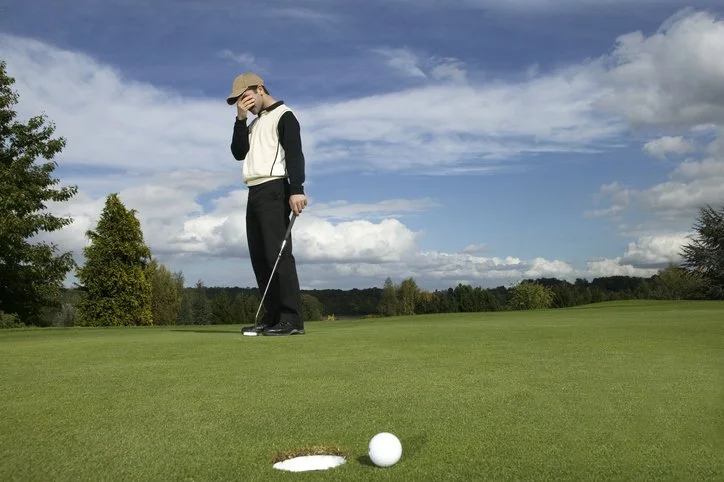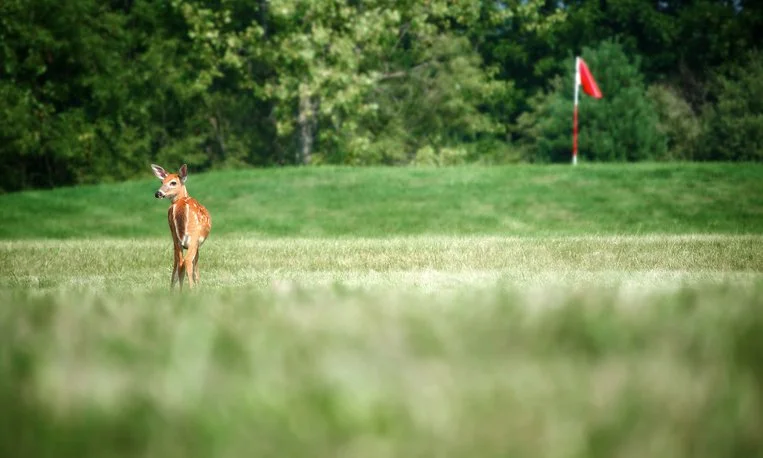Breathwork on the Golf Course: Deer-Inspired Tips for Nervous-System Calm
By: Joy Stephenson-Laws, Holistic Coach, J.D., Founder
Sunrise on the Fairway: An Unexpected Playing Partner
My foursome had bailed, so I found myself alone on the first tee at 7:10 a.m. The air still smelled of cut grass, and the fairways glimmered with dew that hadn’t yet surrendered to the July sun. I teed up, breathed in the peppery scent of wet Bermuda, and let my driver slice through the hush. The ball arced down the middle, a white comet against baby-blue sky.
I slung my bag over one shoulder and walked toward the landing area, savoring the quiet before the maintenance crew’s mowers roared to life. Halfway to my ball, movement flickered near the tree line. At first I thought it was another early golfer—then I realized I was looking at a doe.
She stood ankle-deep in fescue rough, no more than thirty yards away, nose twitching, ears rotating like tiny satellite dishes. Most deer vanish the second they sense company, but this one remained. She simply breathed—slow belly expansion, gentle exhale curls visible in the cool morning light. We locked eyes. I could hear my own heartbeat thudding beneath my polo. She, on the other hand, looked as composed as a yogi in savasana.
After several silent seconds she gave a whole-body shake—head to tail, like drying off invisible rain—then bent to nibble clover between sprinkler heads and melted back into the shadows beyond the cart path.
I shouldered my bag again, but the image trailed me like a caddie with something profound to say. What can that deer teach me about stress—and about breath—on and off the course?
Fairway Stress vs. Forest Calm
A round of golf looks serene, yet every shot carries micro-stressors: out-of-bounds stakes, water carries, gallery eyes during member-guest tournaments. Each trigger nudges the sympathetic nervous system—the fight-or-flight gear—into action. Heart rate spikes, grip tightens, backswing tempo races. Ask any golfer how many strokes tension adds over 18 holes.
Deer operate under far bigger threats—coyotes, cars, the occasional poorly plotted slice—yet they glide from alarm back to calm in seconds. Their knack lies in completing the stress cycle. Danger detected? They sprint. Danger gone? They breathe, shake, graze. Reset finished.
We humans, by contrast, lug our missed-putt frustration to the next tee, then to the office, then to bed, where it morphs into jaw clenching and insomnia. Our biology designed the same off-switch the deer uses, but habit overrides it.
The Shake Heard Round the Forest
Somatic-therapy researchers like Dr. Peter Levine have filmed wild animals after a chase: an antelope quivers head to hoof for twenty seconds, then resumes grazing as though nothing happened. That tremor releases residual adrenaline so it won’t fossilize into chronic tension.
Recall that doe’s shiver on the first fairway. She wasn’t skittish; she was resetting. Humans shake too—knees knocking after a near-miss car accident—but social conditioning tells us to “get it together.” Suppressing the shake traps fight-or-flight chemistry in muscle fibers, where it masquerades as shoulder knots, migraines, or the yips inside six feet.
Breath: Your Built-In Mulligan
Polyvagal theory explains why a single slow exhale can feel like a mulligan for the nervous system. Lengthening your out-breath turns on the vagal “brake,” nudging heart rate down and steering circulation back to digestion and immune repair. Belly breathing is the physiological equivalent of tapping in for par after blasting out of a bunker—order restored.
During solo rounds I now practice “box-plus-two” breathing when a tricky shot looms:
Inhale for four counts as the club settles behind the ball.
Hold for four while visualizing the desired flight path.
Exhale for six, softening grip pressure.
Pause for two counts, letting calm wash through arms and legs.
Three cycles take about forty-five seconds—the perfect span while waiting for the green to clear.
Five Deer-Inspired Reset Moments on the Course
Golf offers natural pauses that mirror a deer’s shake-and-graze rhythm. Try these on your next round:
After a Bad Shot
Pause: Don’t scoop the ball in anger.
Shake: Let the club dangle; wiggle wrists, shoulders, even jaw.
Breathe: One long exhale while watching clouds drift.On the Tee Box
Ground your spikes, feel the earth’s firmness, and inhale cedar-scented air. Exhale as you visualize center-cut fairway.Walking Uphill to the Green
Sync steps to breath: four strides inhale, six strides exhale. Add a slight shoulder roll every few paces.Waiting on a Slow Group
Plant both feet, arms at sides. Micro-shake each leg, then trace a fingertip figure-eight on your palm—tactile focus calms the limbic alarm.Final Putt Jitters
Before the stroke, swallow once (activates vagus), exhale slowly, whisper “Smooth,” roll the rock.
Each reset lasts under a minute yet prevents stress from accumulating like un-raked bunker footprints.
When the Rough Gets Thicker than Fescue
Some tension transcends triple-bogey blues—family illness, job upheaval, world news. For heavier loads, lengthen the practice:
Range Session Flow – Alternate five swings with thirty seconds of diaphragmatic breathing, letting heart rate return to baseline between sets.
Cart-Path Walking Meditation – Park early, walk the last 100 yards to your ball with nose-only breathing and soft focus on birdsong.
19th-Hole Wind-Down – Sit on a bench post-round, feet flat, palms on thighs, eyes half-lidded. Inhale four, exhale eight for five minutes before grabbing the scorecard or the IPA.
Movement plus breath channels sympathetic charge into harmless kinetic energy—exactly what the doe accomplished with her shake.
The Course as Classroom
I used to stride the fairways chasing lower scores and lower handicaps. Now I see each hole as a lesson in mammalian wisdom:
The tee box teaches orientation. Look around, gather data, choose a target.
The swing teaches surrender. Once the downswing starts, thinking ends.
The walk teaches recovery. Every step is an exhale opportunity.
The green teaches presence. Read grain, feel slope, trust motion.
Insert a deer into that curriculum and the syllabus gains its final chapter: complete the stress cycle before stepping to the next shot—or the next day.
Parting Thoughts from the Practice Green
I haven’t seen my dawn doe again, but I thank her each time I slide a putter cover back on with a calm heartbeat. She demonstrated, wordlessly, the original design coded into every mammal: surge, release, restore.
So the next time a duck hook finds water or a phone buzzes mid-backswing, pause on the fringe. Picture a dew-lit deer breathing beneath pines. Shake your limbs, lengthen your exhale, and allow calm to settle like fog over the fairway.
Your scorecard may improve. Your sleep almost certainly will. And your nervous system will nod in quiet gratitude, hoof-print by hoof-print, breath by breath—just as nature intended.
Sometimes the best teachers don’t speak. They just show up, take a breath, and remind us who we really are.
Sources for This Article
Slow Breathing & Parasympathetic Activation
Zaccaro et al. (2018). How Breath-Control Can Change Your Life: A Systematic Review.
Frontiers in Human Neuroscience
Shaking Off Trauma & Somatic Healing
Payne, Levine, & Crane-Godreau (2015). Somatic Experiencing: Interoception and Trauma Therapy.
NIH / PMCPolyvagal Theory & Nervous System Regulation
Porges, S. (2022). Polyvagal Theory: A Science of Safety.
NIH / PMCLagos, L., Vaschillo, E. G., Vaschillo, B., Lehrer, P. M., Bates, M. E., & Pandina, R. J. (2011). Virtual reality–assisted heart-rate-variability biofeedback as a strategy to improve golf performance: A case study. Biofeedback, 39(1), 15-20. https://doi.org/10.5298/1081-5937-39.1.11 ResearchGate
Wilson, E., & Callahan, J. (2015, October 6). The importance of breathing in golf. Keiser University College of Golf Blog. https://collegeofgolf.keiseruniversity.edu/theimportanceofbreathingingolf/







